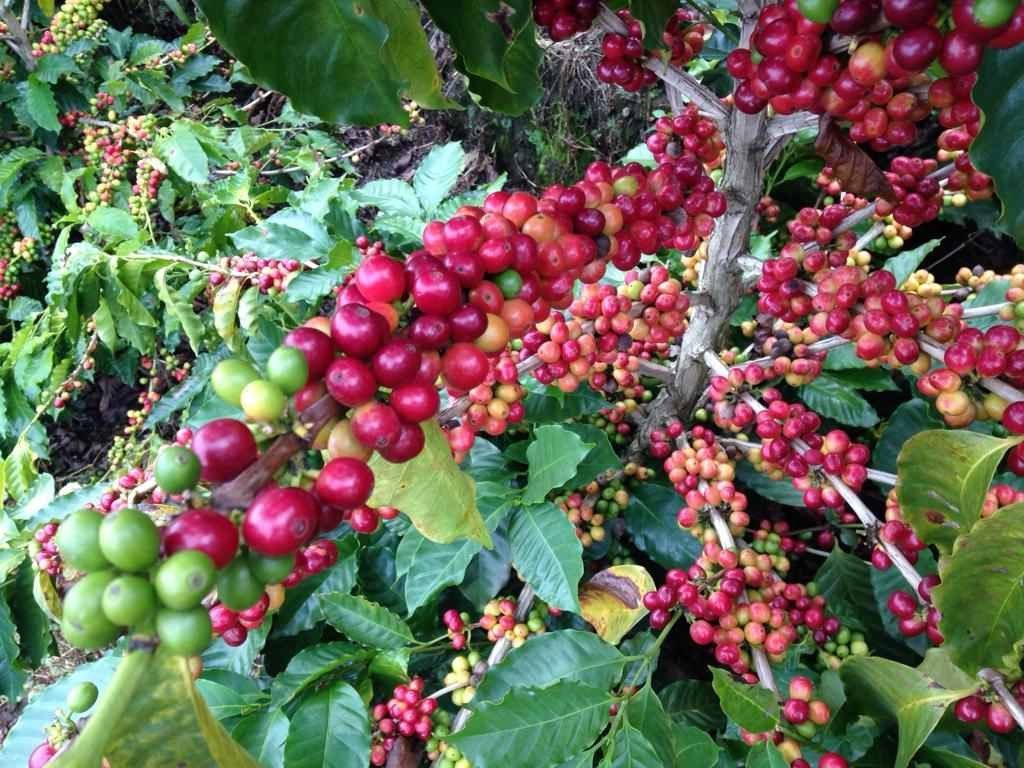
An improved F1 hybrid called Centroamerica (T5296, a Sarchimor x Rume Sudan), which has yields as much as twice as high as traditional varieties, with very good quality potential. Photo courtesy of World Coffee Research.
(Editor’s note: This story originally appeared in the March/April 2016 issue of Roast magazine in the article “Can Science Save Specialty Coffee? World Coffee Research Works Toward the Industry’s Long-Term Survival,” written by Hanna Neuschwander. See Hanna’s bio below for more and click here for more information on Roast.)
One of the most important techniques in coffee breeding is something farmers always have done on their own: selecting the best plants for a given desirable trait. A farmer (or breeder) might desire a plant that produces a high yield of fruit, for example. Perhaps this farmer notices a particular plant on his or her field that seems to be producing more fruit than other plants (possibly because a natural mutation has occurred). The farmer selects seeds from the plant, then plants the seeds and waits for the trees to grow. When these trees reach maturity and produce fruit, the farmer again identifies the highest-producing plants and selects seeds from them, repeating the process over many generations, each time selecting seeds from the plants that bear the most fruit.
In the first few generations, it is likely that some of the off spring plants will have high yields while others won’t, but after careful selection over many generations (often at least six or seven) the high yield should be observed uniformly in the off spring. Once achieved, this uniform plant is called a “pure line.”
Because coffee takes three to four years to mature, getting to the sixth or seventh generation can take 20 years or more. One example is the tekisic cultivar, a selection of bourbon created by the Salvadoran Institute for Coffee Research (ISIC, by its Spanish acronym) in El Salvador, beginning in 1949. It was not released until 1977 — 28 years after selection began. By contrast, F1 hybrids — which are typically crosses between two different pure lines — can get from the experimental phase into farmer fields in as little as five to 10 years.
Let’s say a coffee breeder observes vigorous growth in one coffee, but no resistance to coffee leaf rust. In another coffee, there is disease resistance but lower yield.
Pure lines of each of the two plants are cross-pollinated. The seed resulting from this cross is called an F1 hybrid. Plants grown from this seed should have the best traits of each parent — in this case, good vigor and leaf rust resistance.
There are many advantages to this approach. F1 hybrids tend to have significantly higher production than non-hybrids (frequently producing 30 to 50 percent more fruit), grow more uniformly and produce their first fruit in year two instead of year three. They cannot, however, be reproduced through seeds, because the children of F1 hybrids will not have the same characteristics as the parents — they will perform differently and have less productivity. Because they generally must be produced by nurseries using advanced technologies (including somatic embrogenesis and microcutting), they tend to be more expensive; plants can cost up to twice as much, typically 50 to 70 cents per plant. (The cost, however, is already nearly half what it was 10 years ago.) Even so, because coffee is not an annual crop like corn or wheat, coffee growers do not need to purchase more expensive plants every year — most farmers renovate every 10 years or more — so the resulting increases in yield and uniformity vastly off set the higher initial cost.
Hanna Neuschwander
Hanna Neuschwander is director of communications for World Coffee Research. She has been communicating about coffee and science since 2004. Her writing has appeared in publications including Travel + Leisure, The Art of Eating, Portland Monthly, and Modern Farmer. Based in Portland, Oregon, she is the author of Left Coast Roast, a guidebook to artisan and influential coffee roasters on the West Coast.
Comment
1 Comment
Comments are closed.






Where can I get seedlings